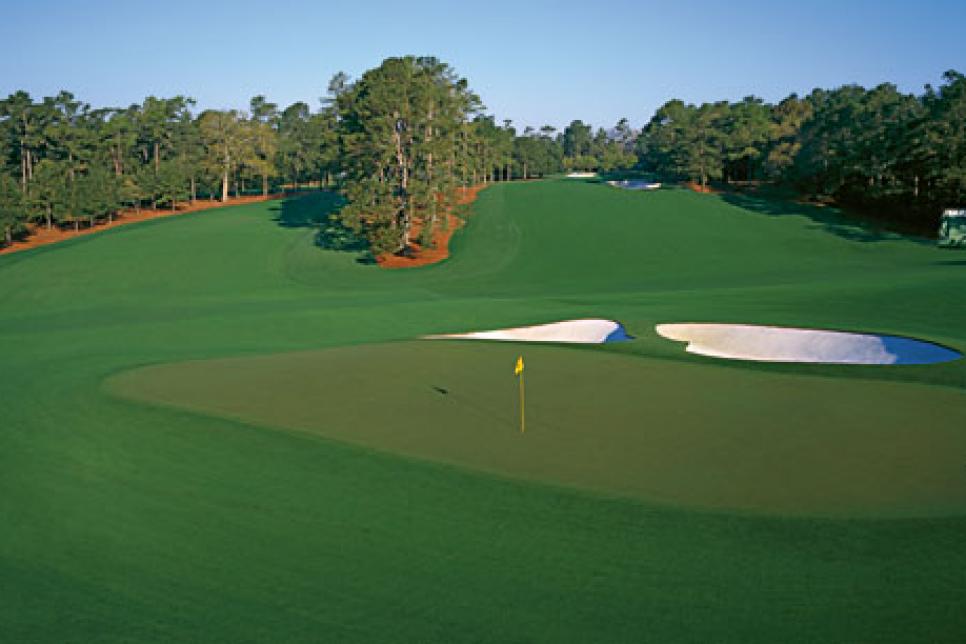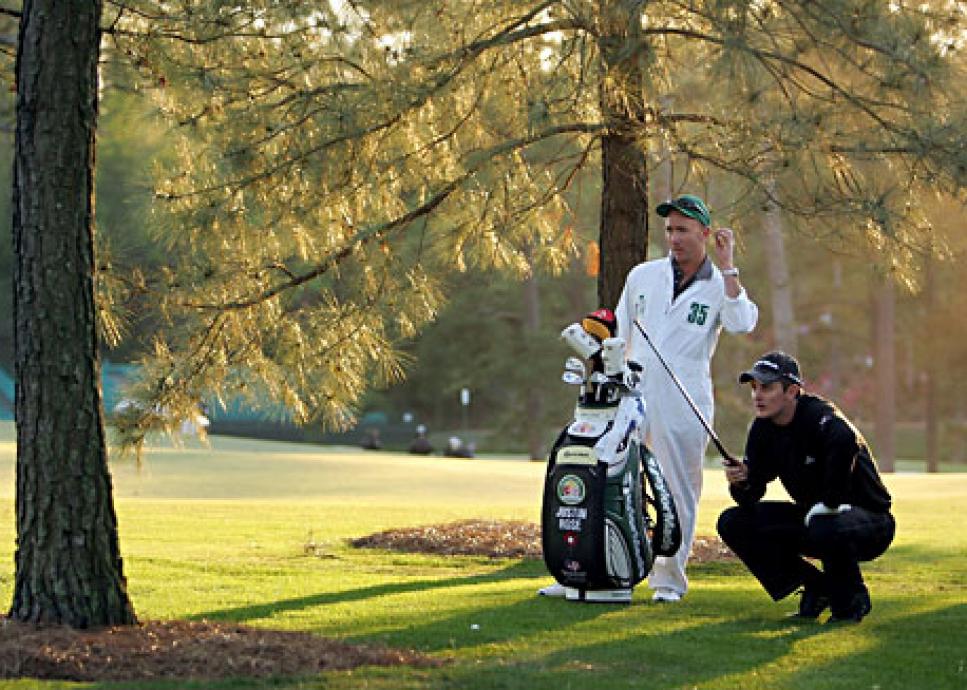News
Second-Guessing

At No. 9 (left) the rough affects tee-shot strategy but on No. 1 it can keep drives out of the trees.
As Masters anniversaries go, this one won't be as celebrated as Gene Sarazen's double eagle or Jack Nicklaus' record sixth green jacket. Yet 2008 will quietly mark the 10th Masters played with 13/8-inch areas of perennial ryegrass that reduce the width of Augusta National GC's once mammoth landing areas, a change that opened the club to a decade of criticism from many of its celebrated past champions.
Intended to create uncertainty for approaches after wayward tee shots, the club insists the "second cut" of flyer-lie inducing turf discreetly offsets a game transformed by technology. Still, plenty of green-jacket owners insist it was an unnecessary addition to a novel design. Most telling may be the failure of the second cut's Augusta-specific name to register with older past champions.
"Oh, you're talking about the rough," 1979 winner Fuzzy Zoeller says when asked whether the taller grass makes the course
harder or easier, the bottom line in a debate that includes matters of tradition, design philosophy and golf-course aesthetics.
"It has probably made the course easier," Zoeller says. "Especially up around the greens. The balls used to roll out and away, and now mis-hit shots stop closer to the green." The club asserts there always has been a second cut, and the 1999 Masters simply marked a change in the mowing lines and terminology. Two-time champion and noted course architect Ben Crenshaw does not agree.
"There was something regal about the place without rough," Crenshaw says. "It stood the test of time and separated itself from all others because it was different."
For as long as most players and patrons can remember, Augusta National astounded first-time visitors with a wall-to-wall cut that looked better than most putting surfaces. When then newly installed chairman Hootie Johnson decided in 1998 that the course was no longer placing a "premium on accuracy," he made the call to alter one of Augusta's most defining characteristics. An old 5/8-inch cut transitioning the course's turf into the "pine mulch" was brought closer to the fairway center lines and allowed to grow nearly an inch taller.
When the club confirmed course lengthening and tree planting between Nos. 15 and 17 in June 1998, there was no official announcement concerning the addition of rough. Instead, rumors abounded that fall about the possibility of narrowed landing areas. Confirmation did not come until February 1999 when two-time champion Bernhard Langer mentioned playing out of the tall stuff during a trip to the club.
"It was about this thick,'' Langer said, holding his fingers an inch apart for Associated Press reporter Doug Ferguson, who wrote that Augusta National's installation of rough would be "the most dramatic change since bentgrass greens were introduced in 1981."
Since the inaugural second-cut Masters, traditionalists have scoffed at the use of man-made fairway contours and manicured rough to seal off Alister Mackenzie and Bobby Jones' democratic, Old Course-inspired routes to the greens.
"You stand on a tee now and you don't really have a choice," says Crenshaw. "There is less thinking involved."
In The Story of the Augusta National Golf Club, longtime chairman Clifford Roberts described the freedom players enjoyed in reaching the "favored fairway location." Roberts wrote: "There are a number of holes that invite a draw or a hooked shot, but none that require it. There are several that invite a fade, but it is not necessary to play a left-to-right tee shot in order to score well."
Crenshaw endorses that summation of the Mackenzie-Jones philosophy. "The more intimate knowledge of how to play the contours, what flags to go at and where to attack them from is the difference between strategic and penal architecture," he says. "But in order to have strategy, you have to have width."
[Ljava.lang.String;@7761f9ad
In a recent statement to Golf Digest, the club says the second cut has not "eliminated preferred angles for the players," yet suggests the debate is moot because "players don't play the angles anymore to the same degree that was done in [Bobby] Jones' day."
Former Masters competition committee chair Will Nicholson once justified the reduction in fairway width to 36.57 yards as "reasonably generous by major championship standards," though at the time he was defending changes in 2000 to the ninth and 10th fairways. (They were later widened to the original 1999 specifications, and the club continues to fine-tune the contour boundaries.)
Architect Tom Fazio oversaw the second cut's installation and originally suggested that definition was the driving force. "When you look down the first fairway, you can really see where to hit the ball," Fazio told the Augusta Chronicle. "Any time you design a course, you want to frame the hole. If you have a picture, and the frame doesn't work, then you get a new frame."
That perceived dig at the original design and the shock of seeing rough at Augusta drew the ire of Nicklaus. "It looks like it's been done by somebody who doesn't play golf or understand the game," he said at the 2000 Masters. "They have taken a golf course that played for years a certain way and now they have eliminated it."
Upon the introduction of the second cut Langer believed it would force the player "to hit better, more accurate shots coming in." A decade later he feels the second cut has made the course more difficult due in large part to "the question of whether a ball will fly or jump." But Langer, like Crenshaw, is troubled by the reduction in choices off the tee. "You don't have the option any more to drive the ball on the sides of a fairway," he says. "It takes several key angles out of the equation. And I think the course was designed with the angles in mind."
Nicklaus recently reiterated his criticism, insisting the rough makes Augusta National look "a lot like everybody else" and stops too many balls "from getting to the trees." "The rough has done what they wanted it to do from the standpoint of making it so [the players] can't spin the ball as easily into the green," Nicklaus said in February. "That's what they've accomplished. But I'm a proponent of no rough." Phil Mickelson seconds Nicklaus' take and insists the second cut "without question" makes the course easier because it is stopping balls from running into the trees.
The average winning score for the nine "second-cut Masters" is 279.1, while the nine prior to the rough averaged 276.1 Players generally chalk up the higher scoring to nearly 500 yards in added length and a few years of extreme weather. "It's not easier because they lengthened the course so much," say 1998 champion Mark O'Meara, who wants to see erratic drives reach the trees because "Augusta has always been about the ball running."
Club officials counter the criticism of former champions by noting that players armed with today's equipment do not hit the ball as far offline, justifying the narrowing. In limited statistics from last year's tournament, the second cut appeared to deliver the hoped-for half-shot penalty while rewarding tee shots adhering closer to the center lines. "[The second cut] is just long enough to where the ball sits down enough and you can't spin it," says Mark Calcavecchia.
Davis Love III says the flyer-lie component has made a huge impact on his strategy, particularly on the par-4 ninth, where drives reaching the bottom of the hill always found the fairway. "I used to just blow it down there and hope to have wedge into the hole, and if I lost it a little right, it was no big deal," Love says. "Now you really have to hit it straight."

Several players acknowledge the impact on the 14th, a bunkerless, uphill par 4 with a steeply pitched fairway that sends many drives into the right rough. Geoff Ogilvy says a second-cut lie there forces the run-up approach "that Bobby Jones intended" and is a shot today's players aren't comfortable playing.
Former U.S. Open and PGA champion David Graham has spent 15 years on the Masters Cup and Tee Marker Placement Committee and sees the second cut making its impact best felt under firm conditions.
"If you put the player on the fairway in firm conditions, he is more likely to execute with more confidence knowing that he's going to make better contact with the ball," Graham says. "If the greens are soft, then I'm not really sure anyone has a plus or minus advantage from the secondary cut."
For every example of increased difficulty, players can point to the rough's helping hand. Raymond Floyd, who won the 1976 Masters, thinks the taller grass is saving many players "from making double and triple bogeys," singling out the par-5 second hole where hooked drives are less likely to reach a little-known creek down the left side.
Sandy Lyle feels the second cut has improved several holes for the player "by giving us more grass under the ball." He cites the shade-prone seventh as well as the area of rough now sitting between the edge of the 13th fairway and the tributary of Rae's Creek. "The thin lies sometimes made it very hard to get clean contact. Now the ball sits up better," Lyle says.
And what about the man who has won three of his four Masters since the addition of the longer grass?
"I think it would play harder now if they took away the second cut," says Tiger Woods. "I'm sure it would be a more interesting test."
Woods is convinced that pulled tee shots on the first two holes are prime examples of Augusta National simplified.
"Now they get held up by the rough -- I'm sorry, second cut."
At least he knows what to call it.